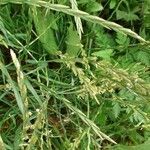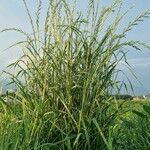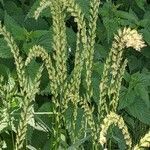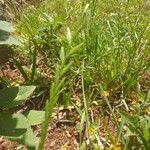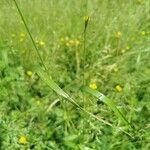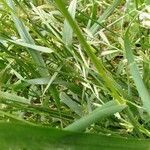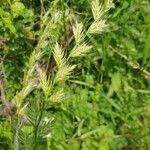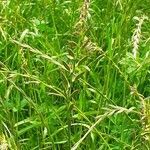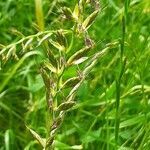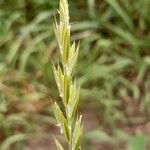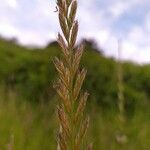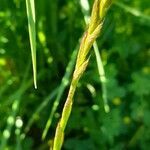Annual, biennial, or short-lived perennial. Culms tufted, erect or decumbent at base, 0.5–1.3 m tall, 4–5-noded. Leaf blades flat, 10–20 cm × 3–8 mm, glabrous, adaxial surface scabrid, young blades rolled; auricles usually present, 1–4 mm; ligule up to 4 mm. Raceme erect or nodding, 10–30 cm; rachis scabridulous, spikelets overlapping or up to their own length apart. Spikelets 0.8–3 cm, florets 8–22; glume lanceolate, much shorter than spikelet, scarcely exceeding lowest floret, 5–7-veined, margin narrowly membranous, apex obtuse, acute or slightly erose; lemmas oblong-lanceolate, 5–8 mm, 5-veined, apex acute, obtuse or erose; awn up to 5(–15) mm, fine, straight, or upper lemmas awnless; palea equal to lemma, ciliolate along keels. Caryopsis length 3 times width. Fl. and fr. Jul–Aug. 2n = 14.
Annual or short-lived perennial. Culms 70–90 cm high; mid-culm nodes not pigmented. Leaves: basal sheaths occasionally purple, becoming straw-coloured; auricles present; blade convolute in bud, 20–31 cm long, 4–9 mm wide. Spike 10–30 cm long, with 21–42 spikelets; axis slender, 0.8–1.7 mm wide, with angles scabrous. Spikelets 10–25 mm long, 2–10 mm wide, with 6–15 bisexual florets; rachilla segments 1.1–1.7 mm long. Glume 1/4–1/2 length of spikelet, c. 1/2 as long as to shortly exceeding basal lemma; upper glume narrowly ovate, 4–9.3 mm long, 5–7-nerved. Lemma laterally compressed, 6.4–7.7 mm long, at least the upper lemmas of spikelets awned, membranous, 5-nerved, often pigmented towards apex; awn slender, to 13 mm long. Caryopsis 2.6–3.8 mm long, 0.7–1.5 mm wide.
Loosely tufted, short-lived perennial or annual, 0.2-0.8(-1.3) m high. Leaf blade 110-220 x 3-8 mm, rolled along axis when young; ligule an unfringed membrane. Inflorescence a spike with spikelets sunk and lying edgeways in partial cavities on alternate sides of central axis. Spikelet 10-15 x 2-10 mm; lower glume present only in terminal spikelet, similar to upper glume; upper glume ascending or spreading, 1/4-1/2(-3/4) as long as spikelet, persistent. Florets 8-20; lemma acute, > 3x as long as wide, not turgid at maturity, awn up to 15 mm long; palea as long as lemma, with 2 minutely rough keels; anther 2.3-4.5 mm long. Flowering time Oct.-Apr. Caryopsis when mature > 3x as long as wide.
Loosely tufted, short-lived perennial or annual, 200-800(-1300) mm high. Leaf blade 110-220 x 3-8 mm, rolled up along the midrib when young. Spikelet 10-15 x 2-10 mm, 8-20-flowered; lower glume present only in the terminal spikelets, similar to upper glume; upper glume ascending or spreading, 1/4-/2(-3/4) as long as spikelet, not concealing the spikelet, persistent; lemma acute, more than 3 x as long as wide, not turgid at maturity, awn to 15 mm long; palea as long as lemma, with 2 minutely rough keels; anther 2.3-4.5 mm long; mature caryopsis more than three times as long as wide.
An annual grass. It grows 60-90 cm high and spreads 25-30 cm wide. It is a more robust grass than Wimmera rye. The stems are often tinged red. The leaves are bright green and smooth and tapered. They have a sharp point. The midrib is obvious and the leaf edges are rough. The flowers are in a spike with 5-38 spikelets. The outside glume is shorter than the spikelet. The lemmas carry awns.
Annual or short-lived perennial; up to 0.8 m high; loosely tufted. Leaf blades 110-220 x 3-8 mm; leaves rolled along midrib when young. Flowers: panicle a single; flat spike; spikelets 8-20 x 2-10 mm; glumes ascending or spreading; not concealing spikelets; 1/4-1/2(-3/4) spikelet length; lemmas acute; not turgid at maturity; awn up to 15 mm long; mature caryopsis > 3 x as long as wide.
Short-lived perennial or annual, loosely tufted, up to 0.8 m high. Leaf blades 110-220 mm long, 3-8 mm wide. Spikelets 8-20 mm long, 2-10 mm wide. Glumes ascending or spreading, not concealing spikelets, a quarter to half (to three-quarters) the spikelet length; lemmas acute, not turgid at maturity, awn to 15 mm long. Mature caryopsis more than 3 times as long as wide.
Leaf-laminae 6-25 x 0·4-1 cm., linear, tapering to a fine soft point, with narrow auricles at the base, involute in young shoots, smooth and glossy on the lower and often scaberulous on the upper surface.
Culms 30-80(100) cm. tall, 2-5-noded, sometimes solitary, simple or branched below, erect or geniculately ascending, smooth or scaberulous beneath the inflorescence.
Lemmas 5-8 mm. long, 5-nerved, awned, imbricate, oblong to lanceolate-oblong, with the apex obtuse and 2-dentate; awn up to 10 mm. long, straight, slender.
Leaf-sheaths prominently striate, dorsally rounded, tight at first, later somewhat loose, smooth or more rarely scaberulous, glabrous.
Spikes 10-30 cm. long, erect or sometimes nodding, rather compressed, often tinged with purple; rhachis usually scabrous.
Superior glume much shorter than the spikelet, 4-7-nerved, narrowly oblong or lanceolate-oblong, obtuse to acute.
Like L. perenne and hybridising with it but sterile shoots absent, leaves rolled when young and lemmas awned.
Spikelets 7·5-25 mm. long, 5-15-flowered, elliptic-oblong to obovate-oblong in lateral view, glabrous.
Paleas scaberulous along the keels.
A caespitose annual or biennial.
Ligule 1-2 mm. long, membranous.
Caryopsis 3-3·5 mm. long.
Anthers 3-4·5 mm. long.
